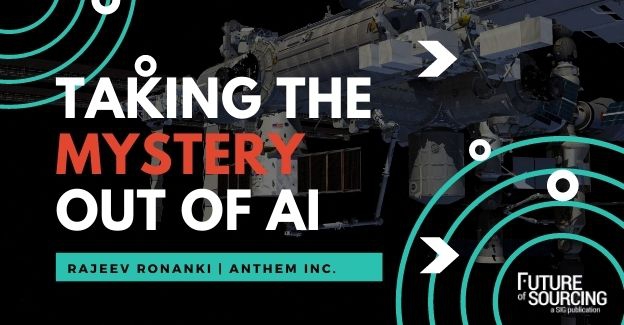Artificial intelligence is significantly impacting the world, yet there’s still a great amount of mystery and misconceptions about it, says Rajeev Ronanki, President of Digital Platforms at Anthem Inc., and the ForbesBooks author of You and AI: A Citizen’s Guide to AI, Blockchain, and Puzzling Together the Future of Healthcare. He explains four primary business applications for applied AI and how they can create value for businesses in all industries.
The public’s imagination has been heavily shaped by science fiction, with the term AI evoking images of robots like WALL-E, C3PO from Star Wars and David from Stephen Spielberg’s movie A.I. Scientists and technologists refer to this kind of humanlike AI as “general artificial intelligence.” General AI attempts to mimic the kind of abstract thought and typical problem-solving skills seen in humans.
I say attempts because there is currently no existing general AI system even approaching the sophistication of the human brain. The technology is nowhere close to creating a system capable of abstract thought or general intelligence. But “applied AI” is rapidly becoming a mainstream technology, improving the efficiency and profitability of businesses in many industries.
Why Applied AI is Faster but Not Yet Smarter Than Us
Current AI systems, for all their computational ability, do not have the ability to understand and analyze context the way human brains do. For example, we can see a barking dog and instantly determine the threat level. Sufficiently advanced AI can recognize the dog but may be unable to determine the breed, its physical agility, and whether it has been encountered before. Unlike humans, AI cannot connect dots and judge context to solve problems creatively.
But AI systems can make decisions faster and more accurately than humans. The strengths and limitations of the current generation of artificial intelligence make it most applicable for solving fit-for-purpose business problems. (Fit-for-purpose is the concept in which a product or service is adequate for the purpose for which the consumer selected it.) AI systems are designed to handle a specific task while operating within imposed contextual constraints. These fit-for-purpose systems and tools are known as applied AI.
There are four primary business applications of applied AI in industry. Here is a look at each and how they create efficiencies and value.
1. Automation
Automation saves countless man hours and resources, as computers can process data in a fraction of the time it takes humans. Some of these processes require decision-making. This is where AI comes into play.
Most business processes involve a structured set of inputs and decisions are made based on defined policies and guidelines. The variables in the equations are well known and operate within a narrow context. Algorithms can make these decisions rapidly and accurately.
These algorithms allow much of the workload that companies do to be offloaded onto automated systems. That advancement provides conveniences for consumers in the age of online shopping.
Banks use AI to automate the loan process. Relevant financial records are collected automatically, validated and analyzed. The system can give a recommendation on the loan before a lender ever sees the application.
This may sound frightening and impersonal, but these systems actually assess loans more accurately and fairly than humans. They look at a borrower’s credit history, credibility, liabilities and other factors to make an impartial decision. Quite often, these individual metrics are also calculated by AI. Credit scores, for example, are calculated automatically.
2. Insights
The data produced by automated business processes holds valuable insights. These insights can be about almost anything; they may reveal something about a business process, unlock untapped opportunities or even allow companies to make predictions about the future.
The data analysis that leads to insights is mostly automated. Given the volume of data that companies now work with, we need these automated AI systems to find the signal in the noise. AI looks for patterns and makes decisions based on training and defined guidelines. The exponential power of these systems can be seen in machine learning.
IBM Watson, for example, can predict when an elevator is going to fail. AI systems are able to return insights about insights into their own operation, and this allows them to improve their data sets and algorithms. As a result, AI systems draw insights that the designers may not have ever considered or been looking for.
3. Personalization
Insights have many applications, but one that is rapidly transforming industries is personalization of user engagement. The insights drawn from consumers, users and other stakeholders can be used to improve their experiences by engaging with them in a personalized manner.
There are many ways companies can use data to personalize the experience for the stakeholders they serve. Google maps knows through habits a driver’s route and daily schedule and will give them an outlook for the day based on the current data.
Retail companies have their websites feature inventory designed to appeal to the specific viewer. Online ads are micro-targeted at individuals based on insights into their specific consumer behavior. Social media platforms also customize news feeds to increase user engagement.
Search engines provide results that are tailored to the user’s location, demographics, search habits, online shopping history and other data.
4. Sensing
Sensing produces a kind of insight that deserves special mention due to its revolutionary potential. The exponential explosion in data and computing power now allows us to better recognize patterns as they are forming and predict how they will develop, which in turn allows us to actually sense trends as they form and develop.
This ability has huge business applications. Consider the sudden rise and success of TikTok. ByteDance, the Beijing-based parent company that developed the app, hit it big by filling an emerging niche for teens who could use a platform for recording and sharing short videos.
TikTok noticed the trend among teens, built a dedicated app and marketed it to the emerging user base as the trend developed. TikTok is now worth billions of dollars and is changing the social media landscape.
Many companies using applied AI have built fortunes and improved the world for billions of people. They did so by leveraging exponential technology and riding the development curve. We can likely achieve higher levels of AI-powered efficiency and improvement in all industries.







